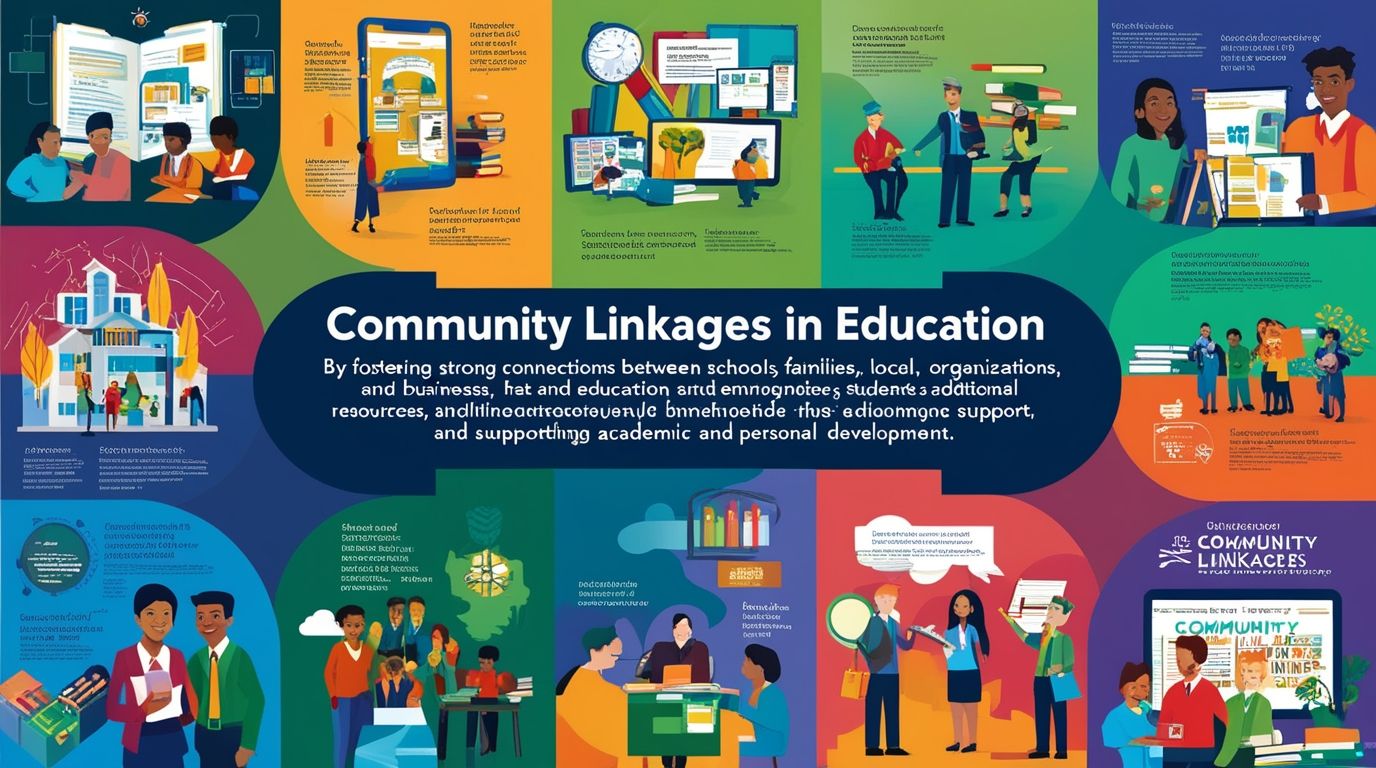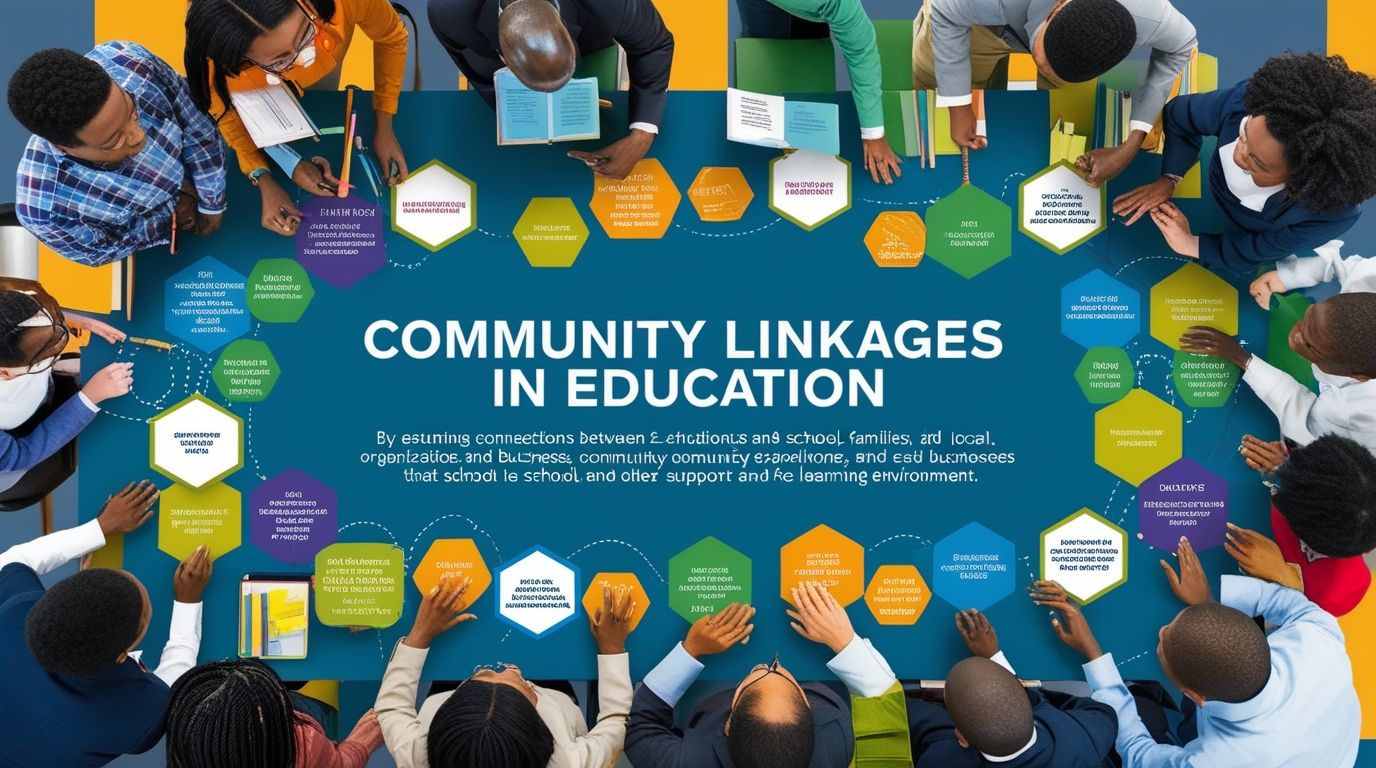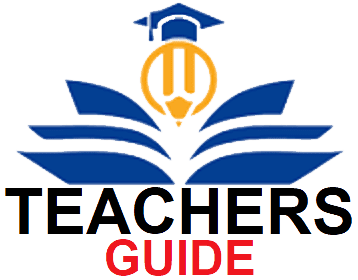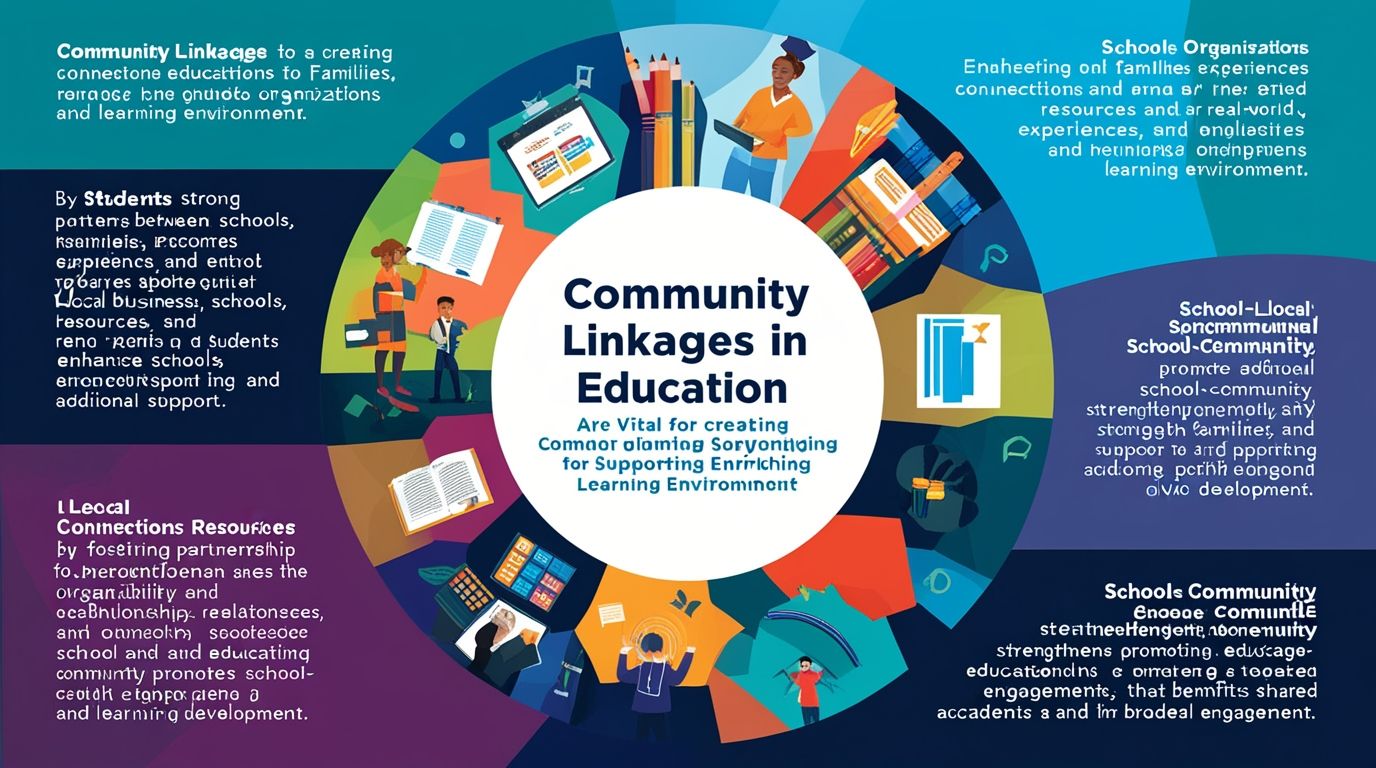Introduction
The Importance of Community Linkages in Education or Education is a vital pillar for the development of individuals and societies. While schools play a central role in delivering education, the involvement of the broader community is equally crucial. Community linkages in education refer to the connections and partnerships between schools, families, local organizations, businesses, and other community members. These relationships help to create a supportive environment that enhances student learning, promotes educational equity, and fosters the overall development of students. This article explores the importance of community linkages in education, the benefits they bring to students, schools, and communities, and strategies for strengthening these connections.
1. Enhancing Student Learning and Development
Community linkages provide students with additional resources, support, and opportunities that can significantly enhance their learning and development. These connections help bridge the gap between classroom learning and real-world experiences, making education more relevant and engaging for students.
1.1. Access to Resources and Expertise
Community partnerships often provide schools with access to resources and expertise that may not be available within the school itself. Local businesses, non-profit organizations, and higher education institutions can offer valuable resources, such as guest speakers, mentorship programs, internships, and extracurricular activities. These opportunities allow students to explore various career paths, develop new skills, and gain hands-on experience that complements their academic learning.
For example, a partnership with a local technology company might provide students with access to the latest software and equipment, as well as opportunities to work on real-world projects under the guidance of industry professionals. Such experiences not only enhance students’ technical skills but also help them develop critical thinking, problem-solving, and collaboration abilities.
1.2. Real-World Learning Opportunities
Community linkages enable schools to offer students real-world learning opportunities that extend beyond the classroom. These experiences can take various forms, including field trips, service-learning projects, and community-based research. By engaging with the community, students can apply their classroom knowledge to real-world challenges, gaining a deeper understanding of the subjects they study.
Service-learning projects, for example, allow students to work on community issues while developing their academic and social skills. A project focused on environmental conservation might involve students working with local environmental organizations to clean up a park, conduct research on local wildlife, or educate the community about sustainable practices. Through these activities, students learn the importance of civic engagement and develop a sense of responsibility towards their community.
1.3. Support for Holistic Development
Community linkages support the holistic development of students by addressing their social, emotional, and physical needs. Schools that collaborate with community organizations, such as mental health services, healthcare providers, and recreational centers, can offer comprehensive support that contributes to students’ overall well-being.
For instance, partnerships with local health clinics can provide students with access to medical and dental care, counseling services, and nutrition programs. These services are particularly important for students from low-income families who may not have access to such resources otherwise. By addressing students’ health and well-being, schools can create a more conducive environment for learning and personal growth.

2. Promoting Educational Equity
Community linkages play a crucial role in promoting educational equity by providing additional support and resources to underserved students and schools. These partnerships can help level the playing field, ensuring that all students, regardless of their background or socioeconomic status, have access to quality education and opportunities.
2.1. Addressing the Needs of Disadvantaged Students
Many students face significant barriers to learning due to factors such as poverty, language barriers, and limited access to educational resources. Community partnerships can help address these challenges by providing targeted support to disadvantaged students. For example, local non-profits might offer tutoring programs, language classes, or after-school activities to help students who are struggling academically or who need additional support.
In communities with high rates of poverty, partnerships with food banks and social services can help ensure that students have access to nutritious meals, stable housing, and other basic needs. By addressing these underlying challenges, schools can create a more equitable learning environment where all students have the opportunity to succeed.
2.2. Fostering Inclusive Education
Community linkages can also promote inclusive education by involving diverse voices and perspectives in the educational process. Collaborations with community organizations that represent different cultural, linguistic, and socioeconomic groups can help schools better understand and meet the needs of their diverse student populations.
For example, partnerships with cultural organizations can provide schools with resources and programs that celebrate the cultural heritage of their students. This might include cultural festivals, language classes, or curriculum materials that reflect the diverse backgrounds of students. By fostering an inclusive environment, schools can help all students feel valued and respected, which is essential for their academic and social development.
2.3. Closing the Achievement Gap
The achievement gap between students from different socioeconomic backgrounds is a significant challenge in education. Community linkages can help close this gap by providing additional academic support, enrichment opportunities, and resources to students who need them most.
For instance, partnerships with local libraries, museums, and educational organizations can offer students access to resources and programs that they might not otherwise have. These opportunities can include summer learning programs, STEM (science, technology, engineering, and mathematics) workshops, or reading initiatives that encourage a love of learning. By providing these resources, community partnerships can help students from disadvantaged backgrounds reach their full academic potential.

3. Strengthening School-Community Relationships
Strong relationships between schools and the community are essential for creating a supportive and collaborative environment that benefits both students and the wider community. These relationships foster mutual trust, respect, and understanding, which are key to the success of educational initiatives.
3.1. Building Trust and Engagement
Building trust between schools and the community is crucial for the success of any partnership. Schools must actively engage with community members, including parents, local organizations, and businesses, to build strong relationships based on mutual respect and shared goals.
One way to build trust is through regular communication and collaboration. Schools can host community meetings, open houses, and workshops to keep community members informed and involved in the educational process. By actively listening to the concerns and ideas of community members, schools can build a sense of ownership and partnership that benefits everyone involved.
3.2. Encouraging Parental Involvement
Parental involvement is a key component of community linkages in education. When parents are actively engaged in their children’s education, students are more likely to succeed academically and socially. Schools can encourage parental involvement by creating a welcoming and inclusive environment, offering resources and support for parents, and providing opportunities for them to participate in school activities.
For example, schools can offer workshops and resources to help parents support their children’s learning at home. These might include literacy programs, parenting classes, or technology training. Additionally, schools can create volunteer opportunities for parents to get involved in the classroom, extracurricular activities, or school governance. By involving parents in the educational process, schools can strengthen the home-school connection and support student success.
3.3. Leveraging Local Expertise and Resources
Communities are rich in resources and expertise that can enhance the educational experience. Schools can leverage these assets by forming partnerships with local businesses, cultural institutions, and community organizations. These partnerships can provide students with access to real-world experiences, mentorship, and resources that enrich their learning.
For example, a partnership with a local museum might allow students to participate in hands-on learning experiences related to history, science, or the arts. A collaboration with a local business could provide students with internships or job shadowing opportunities, helping them explore potential career paths. By tapping into the resources and expertise of the community, schools can offer students a more well-rounded and meaningful education.
4. Fostering Civic Engagement and Social Responsibility
Community linkages in education help foster civic engagement and social responsibility among students. By involving students in community-based projects and encouraging them to engage with local issues, schools can help develop a sense of civic duty and a commitment to making a positive impact on society.
4.1. Service-Learning and Community Projects
Service-learning is a powerful educational approach that combines academic learning with community service. Through service-learning projects, students apply what they have learned in the classroom to real-world challenges, while also giving back to their community.
For example, students might participate in a service-learning project focused on environmental sustainability, where they work with local organizations to clean up parks, plant trees, or educate the community about recycling. These projects not only reinforce academic concepts but also teach students the importance of civic engagement and social responsibility.
4.2. Developing Leadership Skills
Community linkages provide students with opportunities to develop leadership skills by taking on roles in community projects, student organizations, or school governance. By working with community partners, students can learn how to organize events, lead teams, and advocate for causes they care about.
For example, students involved in a community health initiative might lead a campaign to raise awareness about healthy eating or mental health. By taking on leadership roles, students develop confidence, communication skills, and a sense of agency that will serve them well in their future endeavors.
4.3. Cultivating a Sense of Belonging
Strong community linkages help cultivate a sense of belonging among students by connecting them to their community and helping them understand their role in society. When students feel connected to their community, they are more likely to be engaged in their education and motivated to contribute positively to society.
Schools can foster this sense of belonging by involving students in community events, recognizing their contributions to community projects, and celebrating their achievements. By helping students see themselves as active and valued members of their community, schools can nurture a lifelong commitment to civic engagement and social responsibility.
Conclusion
Community linkages in education are essential for creating a supportive and enriching learning environment that benefits students, schools, and communities. These partnerships enhance student learning and development, promote educational equity, strengthen school-community relationships, and foster civic engagement and social responsibility.
By actively building and maintaining these connections, schools can provide students with the resources, opportunities, and support they need to succeed academically and personally. Moreover, by involving the community.


A powerful share, I simply given this onto a colleague who was doing slightly analysis on this. And he in truth bought me breakfast because I discovered it for him.. smile. So let me reword that: Thnx for the deal with! However yeah Thnkx for spending the time to debate this, I really feel strongly about it and love reading more on this topic. If attainable, as you change into experience, would you mind updating your blog with extra details? It’s highly helpful for me. Massive thumb up for this blog put up!
keevvo
z3b4tq
tlgx4m
h76kfe
Nikmati Permainan Slot Gacor di sigmaslot dengan RTP Tinggi dan Jackpot Menggoda
xn7kzx
Make mornings more adorable with this Hello Kitty alarm clock CD player. Ideal for kids and collectors alike, this charming CD clock radio includes all the basics: AM/FM radio, programmable CD playback, and reliable alarm settings. Wake up to your favorite CD or a cheerful radio station with built-in stereo sound. A large digital display and simple controls make it easy to use, even for younger users. Combining cuteness with functionality, it’s a top pick among themed alarm clocks with CD players that bring fun and joy to your space.
Hello, Neat post. There’s a problem with your web site in internet explorer, may test this?K IE still is the market leader and a huge component of people will pass over your excellent writing because of this problem.
Este site é realmente demais. Sempre que acesso eu encontro coisas incríveis Você também vai querer acessar o nosso site e descobrir detalhes! informaçõesexclusivas. Venha saber mais agora! 🙂
incrível este conteúdo. Gostei muito. Aproveitem e vejam este site. informações, novidades e muito mais. Não deixem de acessar para descobrir mais. Obrigado a todos e até mais. 🙂
I’d perpetually want to be update on new blog posts on this internet site, saved to fav! .
obviously like your web-site but you need to test the spelling on quite a few of your posts. Many of them are rife with spelling issues and I in finding it very troublesome to tell the reality however I will surely come back again.
Thanks for any other wonderful article. Where else may anyone get that kind of info in such an ideal approach of writing? I’ve a presentation next week, and I’m on the search for such info.
This is very interesting, You are a very skilled blogger. I’ve joined your feed and look forward to seeking more of your fantastic post. Also, I have shared your website in my social networks!
Great blog here! Also your website loads up fast! What web host are you using? Can I get your affiliate link to your host? I wish my site loaded up as fast as yours lol
Some genuinely great information, Gladiola I found this. “What’s a man’s age He must hurry more, that’s all Cram in a day, what his youth took a year to hold.” by Robert Browning.
I will immediately snatch your rss feed as I can not in finding your e-mail subscription hyperlink or newsletter service. Do you’ve any? Kindly let me recognize in order that I could subscribe. Thanks.
Please let me know if you’re looking for a writer for your site. You have some really good articles and I feel I would be a good asset. If you ever want to take some of the load off, I’d love to write some articles for your blog in exchange for a link back to mine. Please blast me an e-mail if interested. Thanks!
Someone essentially help to make seriously posts I would state. This is the very first time I frequented your website page and thus far? I amazed with the research you made to make this particular publish extraordinary. Magnificent job!